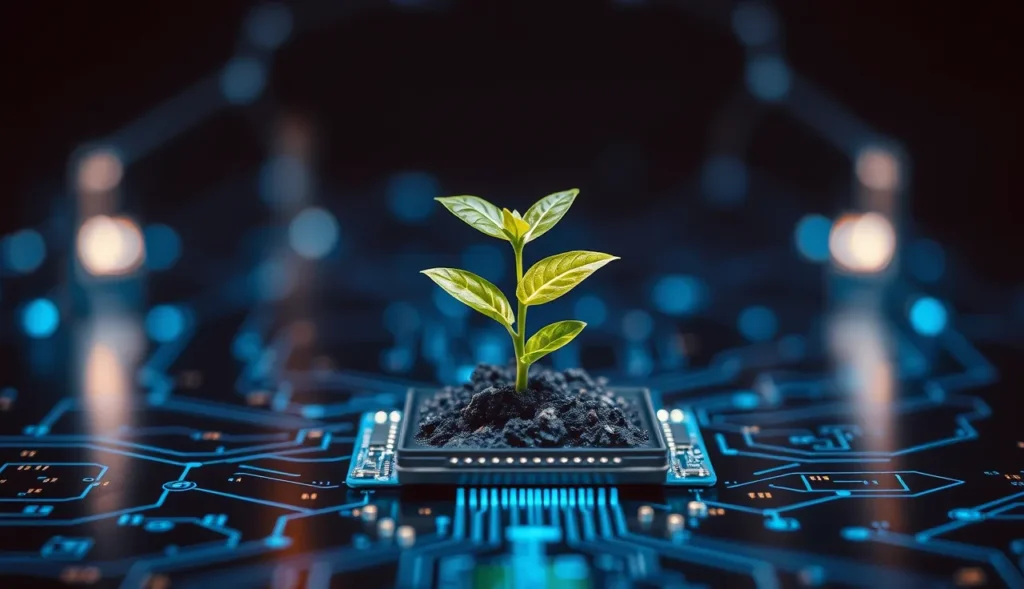
Why AI Needs to Be Energy-Efficient
AI’s Growing Environmental Footprint
Training large-scale models, like GPT-3, requires immense computational resources. These processes consume significant electricity, primarily from non-renewable sources, increasing carbon emissions.
As AI scales, its energy consumption grows too. A study by OpenAI revealed that training modern AI models has increased energy demands by over 300,000 times since 2012. This unsustainable trend poses serious environmental risks.
How Training Models Consume Energy
At its core, training an AI model involves iterative processing, optimization, and testing. These operations depend on high-performance hardware, which guzzles power. Data centers housing GPUs and TPUs also need cooling systems, further compounding energy use.
Reducing energy consumption starts with rethinking our approach—starting at the algorithmic level.
Mean Squared Error (MSE) and Its Role in AI Models
The Basics of MSE in Machine Learning
Mean Squared Error (MSE) is a popular loss function in regression models. By calculating the average squared difference between predicted and actual values, it measures accuracy. Lower MSE indicates better predictions, making it a staple in AI.
Why MSE is Popular in Loss Functions
MSE’s simplicity and clear mathematical properties make it ideal for training models. It offers gradient-friendly behavior, enabling smooth optimization during backpropagation. Developers favor it because it balances precision and computational ease.
Drawbacks of MSE Regarding Energy Efficiency
However, MSE’s strengths come with a trade-off. The focus on high precision often leads to longer training times. Models may require extra iterations to minimize MSE, leading to excessive energy use.
This drawback highlights the need for loss functions that balance accuracy with sustainability.
The Environmental Impact of MSE
High Computational Demands of Precision
Optimizing for low MSE often involves fine-tuning hyperparameters and running extended epochs. While this improves results, it multiplies the energy required for computation.
For example, achieving a fractional improvement in MSE might demand thousands more iterations, each consuming power.
Excessive Iterations and Carbon Costs
Each iteration adds up in carbon emissions. Data centers contribute roughly 2% of global CO₂ emissions, according to the International Energy Agency (IEA). Optimizing for MSE compounds this issue, especially for large-scale models.
Real-World Examples
Consider Google’s BERT model. Reducing its error rates to competitive levels consumed the energy equivalent of a cross-country flight. Such examples reveal the hidden costs of high-performance AI.
Green Computing: The Next Frontier

Introduction to Green Computing in AI
Green computing focuses on designing systems to minimize environmental impact. For AI, this means optimizing algorithms, hardware, and processes to reduce energy consumption without sacrificing performance.
Goals: Reducing Carbon Footprint Without Losing Accuracy
The primary challenge is finding a sweet spot—delivering competitive results while cutting down carbon costs. This involves rethinking traditional techniques, like MSE, and introducing more efficient alternatives.
Why Optimization Algorithms Matter
Loss functions dictate how models learn and adapt. A less energy-intensive algorithm could redefine sustainability in AI. Such changes don’t just improve efficiency—they also reduce operational costs and make AI more accessible.
Rethinking Loss Functions for Sustainability
Alternative Loss Functions to MSE
Some loss functions, like Huber loss or Mean Absolute Error (MAE), may require fewer iterations to converge. While they’re less sensitive to outliers, they can save energy during training.
Trade-Offs Between Energy Use and Performance
Switching from MSE to energy-efficient alternatives involves a trade-off. While performance might dip slightly, the environmental savings could justify the change, especially for less-critical tasks.
Balancing Innovation and Sustainability
By reimagining loss functions and prioritizing energy efficiency, the AI community can strike a balance. The shift may involve short-term sacrifices but offers long-term environmental gains.
Energy-Efficient Algorithms: A Closer Look

Techniques for Reducing Energy Use in AI
Reducing AI’s energy footprint begins with smarter algorithms. Techniques like pruning and quantization shrink model sizes without major accuracy loss. Pruned models eliminate unnecessary parameters, while quantization reduces data precision, saving computational power.
Another key innovation is early stopping, where training halts once performance gains plateau. This avoids wasteful energy spent on diminishing returns.
Case Studies of Successful Implementation
Take OpenAI’s DALL-E models. By incorporating efficiency-first strategies, they reduced the computational load without compromising creativity. Similarly, DeepMind’s AlphaFold streamlined protein folding computations by optimizing their algorithms, cutting energy consumption significantly.
The Role of Hardware in Optimizing Efficiency
Algorithms alone can’t solve the energy problem. Specialized hardware like TPUs (Tensor Processing Units) is designed for AI workloads, delivering higher performance per watt than general-purpose processors. This synergy of optimized algorithms and hardware accelerates green AI.
The Future of Loss Functions in Green AI
How AI Developers Are Approaching the Problem
AI developers are exploring hybrid loss functions that blend efficiency with precision. For example, loss functions tailored to specific datasets minimize overtraining while reducing iterations.
Others are experimenting with dynamic loss functions, which adjust their parameters as models converge. These innovations can lower energy use during training and deployment.
Emerging Trends in Loss Function Research
Green AI research increasingly focuses on energy-awareness during model design. Advances like adaptive gradient methods and sparse optimization align with sustainability goals. Researchers aim to refine MSE alternatives to better suit energy-efficient applications.
Can AI Solve Its Own Energy Problems?
Interestingly, AI is being used to optimize AI itself. Meta-learning algorithms tweak hyperparameters and loss functions to balance performance with sustainability. This self-optimization loop could pave the way for greener AI systems.
Real-World Applications of Green AI
Industries Benefiting from Energy-Efficient AI
Green AI solutions are making waves across industries. In healthcare, efficient models power diagnostics and drug discovery without high energy costs. Similarly, in transportation, energy-efficient AI underpins route optimization and autonomous vehicles.
Examples in Healthcare, Transportation, and More
For example, AI-driven logistics platforms like UPS’s ORION system optimize delivery routes, reducing fuel usage and emissions. In healthcare, smaller, efficient models allow remote diagnostics in energy-constrained environments, like rural clinics.
Success Stories
Amazon has adopted energy-efficient AI in its data centers, reducing energy consumption by up to 50%. These real-world wins showcase how green AI drives both sustainability and profitability.
Challenges in Implementing Green Computing Practices

Barriers to Adoption in the Tech Industry
The path to green AI faces hurdles. Companies often prioritize accuracy and speed over sustainability. Additionally, legacy systems and hardware make transitions costly.
There’s also a knowledge gap—developers may not be familiar with green practices or efficient algorithms. Without training, widespread adoption remains slow.
Balancing Cost, Accuracy, and Sustainability
Sustainability often comes at a short-term cost. Developers may need to retool models, sacrificing marginal gains in accuracy. Striking this balance requires a cultural shift in how AI projects are evaluated and funded.
Need for Collaboration
No single entity can tackle this alone. Collaboration between academia, industry, and governments is crucial. Joint efforts can standardize green AI practices and encourage resource sharing, speeding adoption.
Policy and Standards for Sustainable AI
Current Frameworks and Regulations
Policymakers are beginning to recognize AI’s environmental impact. The European Union’s AI Act and initiatives by the UN focus on accountability in AI development. These frameworks aim to balance innovation with sustainability goals.
What Governments and Organizations Are Doing
Governments are incentivizing green AI through carbon credits and grants. Organizations like Partnership on AI promote responsible AI practices, offering resources for developers to adopt energy-efficient techniques.
Encouraging Energy Accountability in AI Development
Transparency is key. Developers and companies should report energy usage and emissions metrics for AI projects. Public awareness and regulatory pressure can drive the industry toward energy accountability.
How Developers Can Make AI More Energy-Efficient
Tools and Frameworks for Green AI
Developers have access to a growing suite of tools to reduce energy consumption. PyTorch Lightning and TensorFlow’s Model Optimization Toolkit simplify pruning, quantization, and other efficiency techniques.
Other platforms, like CodeCarbon, help track a project’s carbon footprint, empowering developers to make informed choices. These tools turn sustainability into a practical, measurable goal.
Tips for Optimizing Code and Model Architecture
Smaller models are inherently more energy-efficient. Techniques like transfer learning allow developers to build on pre-trained models, drastically reducing computational costs. Additionally, optimizing code for parallel processing and minimizing redundant computations can make a noticeable difference.
Encouraging Smaller, More Efficient Models
The move towards “tiny AI” emphasizes creating smaller models that excel in specific tasks rather than trying to generalize for everything. Tools like DistilBERT and MobileNet show that smaller models can perform well, even in resource-constrained environments.
Collaborative Efforts for Green AI
Open-Source Contributions to Sustainable Computing
Open-source communities are driving innovation in green AI. Projects like Hugging Face’s Transformers promote efficient models by encouraging shared development. Collaboration ensures solutions are accessible to a wider audience.
Partnerships Between Academia and Industry
Universities and tech companies are teaming up to explore energy-efficient methods. For example, Google collaborates with academic researchers to refine TPUs, ensuring they align with sustainability goals.
Community-Driven Solutions
Grassroots initiatives, such as Climate Change AI, unite researchers and developers to address AI’s environmental impact. These communities share resources, host events, and advocate for sustainable practices, proving collective efforts can spark real change.
Quantifying Energy Savings in AI Models
Tools for Measuring Energy Efficiency
Measuring energy use is essential for improvement. Tools like Experiment Impact Tracker and Green Algorithms provide metrics for energy consumption, making it easier to compare models.
Metrics Beyond Carbon Footprint
While carbon footprint is a critical metric, other indicators like energy per epoch or hardware utilization rates offer deeper insights into model efficiency. Together, these metrics provide a comprehensive picture of sustainability.
Case Studies in Measuring Impact
In one case, researchers used the Experiment Impact Tracker to measure the energy use of training BERT. The findings revealed that even small adjustments in batch size and learning rate could save over 20% of energy during training.
Consumer Awareness and Demand for Green AI
Educating Users on the Environmental Impact of AI
Consumers are becoming more conscious of AI’s environmental cost. Clear information about energy use and emissions can help users make informed choices. Companies can display these metrics alongside features, encouraging responsible consumption.
How Consumer Pressure Can Drive Change
Just as consumers demand sustainable products in other industries, a push for green AI can reshape priorities in tech. Companies are more likely to innovate when there’s market demand for eco-friendly solutions.
Aligning Green AI with Market Trends
The market for sustainable technology is booming. Aligning AI solutions with this trend not only boosts environmental impact but also drives revenue. Companies that lead in green AI can position themselves as ethical and forward-thinking, attracting socially conscious customers.
The Road Ahead: Balancing Innovation and Responsibility
Lessons From Other Industries
Other sectors, such as renewable energy and electric vehicles, demonstrate that sustainability and innovation can go hand in hand. AI must follow a similar trajectory, embracing long-term environmental goals.
Potential for Breakthroughs in Green AI
Advances in quantum computing and neuromorphic chips could revolutionize energy efficiency in AI. These breakthroughs, combined with refined algorithms, offer a promising path forward.
A Call to Action for the Tech Community
The responsibility lies with everyone—developers, researchers, policymakers, and consumers. By embracing green practices, the AI community can lead the charge for sustainable innovation, ensuring technology works for the planet, not against it.
Conclusion
As AI continues to transform the world, we must address its environmental impact. From rethinking mean squared error to adopting energy-efficient algorithms, every step toward greener computing is a step toward a more sustainable future. Collaboration, innovation, and awareness are key. Together, we can ensure that AI not only drives progress but does so responsibly, leaving a cleaner, greener world for generations to come.
FAQs
Why is Mean Squared Error (MSE) problematic for energy efficiency?
MSE demands high precision, often requiring extended training periods and numerous iterations. This increases computational load and energy consumption. For instance, achieving marginal accuracy improvements using MSE may double or triple energy use, especially in large datasets.
What are alternative loss functions to MSE?
Loss functions like Huber loss and Mean Absolute Error (MAE) offer energy-efficient alternatives. Huber loss is robust to outliers and converges faster, reducing training time. For applications like predictive maintenance, where energy constraints exist, MAE is often preferred due to its simplicity.
Can energy-efficient AI maintain high accuracy?
Yes, energy-efficient AI can maintain high accuracy when carefully optimized. For example, by combining techniques like pruning and quantization with alternatives to MSE, developers can reduce energy consumption without sacrificing performance. Google’s MobileNet demonstrates how efficient models can still excel in image recognition tasks.
What tools can help developers create energy-efficient AI?
Several tools are available for developers:
- TensorFlow Model Optimization Toolkit: Helps with pruning and quantization.
- CodeCarbon: Tracks the carbon footprint of AI models during development.
- Experiment Impact Tracker: Measures energy consumption and emissions.
These tools make it easier to integrate green computing into the AI lifecycle.
How does green AI benefit industries?
Energy-efficient AI has practical applications across industries:
- Healthcare: Efficient models enable faster diagnostics with lower energy costs, ideal for remote clinics.
- Transportation: AI-powered logistics systems like UPS’s ORION optimize routes, cutting fuel usage.
- Finance: Energy-efficient fraud detection models reduce server demands without compromising speed.
What role do consumers play in promoting green AI?
Consumers influence green AI adoption by demanding sustainable practices. For example, choosing products from companies that emphasize energy-efficient AI encourages the industry to prioritize sustainability. Public awareness campaigns about AI’s environmental impact further amplify this shift.
Are there policies supporting sustainable AI development?
Yes, policies like the EU’s AI Act and global initiatives like Partnership on AI promote responsible AI development. These frameworks focus on reducing energy consumption, transparency in emissions reporting, and encouraging green innovations in AI.
What are the future trends in energy-efficient AI?
Emerging trends include:
- Self-optimizing algorithms: AI models that tweak their own parameters to balance energy and performance.
- Neuromorphic computing: Mimicking the human brain’s efficiency for energy savings.
- Dynamic loss functions: Adapting loss functions during training to reduce energy demands while retaining accuracy.
These advancements hold promise for reducing AI’s environmental footprint while driving innovation.
How can companies balance sustainability with cost and performance?
Companies can balance these factors by adopting a hybrid approach:
- Use smaller, task-specific models instead of general-purpose ones.
- Leverage transfer learning to reduce training times.
- Invest in energy-efficient hardware like TPUs or edge devices.
For instance, deploying lightweight AI models for speech recognition on devices like smartphones can cut energy usage while maintaining a high user experience.
How do pruning and quantization reduce energy consumption?
Pruning involves removing redundant parameters from models, while quantization reduces the precision of calculations. Together, these techniques reduce the computational load and memory requirements. For example, Facebook AI achieved a 90% reduction in model size for certain applications using pruning and quantization.
What industries benefit the most from energy-efficient AI?
Energy-efficient AI is particularly transformative in industries with high operational costs or limited resources:
- Retail: Efficient AI powers inventory management without draining energy in large warehouses.
- Agriculture: AI-driven irrigation systems use lightweight models to conserve water and energy.
- Education: Smaller, energy-efficient models enable AI-based learning tools in remote areas with limited electricity.
How can AI be deployed sustainably in resource-constrained environments?
AI models designed for edge devices can run locally instead of relying on energy-intensive cloud systems. This reduces latency and energy consumption. For example, AI-powered crop monitoring tools in rural areas use compact models that operate on solar-powered devices, minimizing resource strain.
How do dynamic loss functions contribute to sustainability?
Dynamic loss functions adjust their parameters during training, focusing on critical errors initially and relaxing as the model converges. This shortens training time and reduces energy usage. For instance, researchers at Stanford University demonstrated that dynamic loss functions cut training times by 30% while maintaining accuracy for NLP tasks.
Are smaller models always better for sustainability?
Not always. While smaller models save energy, they may require more data preprocessing or additional steps to reach similar accuracy levels. The key is to balance model size with the specific use case. For example, DistilBERT is a smaller version of BERT, optimized for speed and energy but still capable of high performance in text classification.
How can policymakers encourage sustainable AI practices?
Policymakers can introduce measures like:
- Tax incentives for companies using green AI practices.
- Mandating energy usage disclosures for AI models in large enterprises.
- Funding research in energy-efficient algorithms and hardware.
The EU’s Green Deal has provisions for promoting green technology, including AI, which sets an excellent example for global standards.
Is renewable energy enough to make AI sustainable?
While renewable energy reduces emissions, it doesn’t solve AI’s inefficiency. The key is combining renewables with optimized algorithms and energy-conscious hardware. For example, even solar-powered data centers benefit from efficient models to maximize resource use.
What are lightweight AI models, and why are they important?
Lightweight AI models are simplified versions of larger systems, designed to perform specific tasks with minimal resources. They’re crucial for applications like IoT devices, where power and memory are limited. Models like MobileNet can process real-time image recognition on smartphones, offering energy-efficient solutions without relying on large-scale servers.
Can AI self-regulate its energy consumption?
Emerging meta-learning techniques allow AI systems to monitor and adjust their energy usage dynamically. For example, an AI-powered smart thermostat can balance heating efficiency and energy savings by analyzing patterns in real time, ensuring it only uses the required energy. This principle could extend to larger systems in the future.
Resources
Research Papers and Publications
- “Energy and Policy Considerations for Deep Learning in NLP” – A comprehensive study by Strubell et al. that explores the environmental impact of deep learning, particularly in natural language processing.
Read the paper here - “Green AI” by Roy Schwartz et al. – This paper highlights the need for AI research to prioritize energy efficiency alongside performance.
Available on arXiv - “On the Opportunities and Risks of Foundation Models” – Discusses the implications of large-scale models and potential sustainability challenges.
Stanford HAI link
Tools and Frameworks
- CodeCarbon – A tool for tracking the carbon footprint of your AI projects.
Explore CodeCarbon - TensorFlow Model Optimization Toolkit – A suite of tools for model pruning, quantization, and other energy-saving techniques.
Visit TensorFlow Optimization Toolkit - Experiment Impact Tracker – Tracks energy usage and emissions of machine learning experiments.
Learn more here
Blogs and Articles
- Google AI Blog – Posts about innovations in energy-efficient AI hardware like TPUs and sustainable practices in AI.
Visit Google AI Blog - Hugging Face Blog – Shares insights into smaller, more efficient models like DistilBERT and their environmental advantages.
Visit Hugging Face Blog - DeepMind Blog: Sustainability – Highlights efforts to reduce the energy consumption of AI systems.
DeepMind Sustainability
Organizations and Initiatives
- Climate Change AI – A global initiative focusing on the intersection of AI and environmental sustainability.
Climate Change AI - Partnership on AI – Promotes responsible AI practices, including sustainability efforts.
Visit Partnership on AI - Allen Institute for AI (AI2) – Researching energy-efficient AI methodologies.
AI2 Website
Books
- “Sustainability in AI and Data Science” by Woan Foong Wong – A beginner-friendly guide to understanding the environmental impact of AI systems.
[Find on Amazon or local retailers] - “Efficient Processing of Deep Neural Networks” by Vivienne Sze – Focuses on hardware and algorithm optimizations for energy efficiency.
[Available on academic platforms and bookstores] - “Green Technologies and Sustainable Computing” – A broader look at green computing practices, including AI applications.
[Check university libraries or online bookstores]
Communities and Forums
- Reddit: r/MachineLearning – Threads often discuss efficient algorithms and sustainable practices.
Visit r/MachineLearning - LinkedIn Groups – Search for groups focused on green AI or sustainable technology. For example, “AI for Sustainability” is an active community.
- Kaggle Competitions – Look for competitions that prioritize energy-efficient solutions, often tied to real-world applications.
Kaggle